Southern right whales/tohorā
Introduction
These baleen whales can be recognised easily by their strongly arched mouth, lack of dorsal fin and V-shaped blowhole spray.Their head and lower jaw is covered with callosities; large, white, rough growths on the skin that are usually infested with parasitic worms, whale lice and barnacles. The number and arrangement of these are unique to each animal, making it possible to identify individuals and track their movements.
Your help is urgently sought to look out for tohorā around New Zealand and to report sightings immediately.
Facts
Southern right whales (Eubalaena australis) are typically black in colour but can have irregular white patches. The flippers are large and paddle-shaped. Tohorā are slow swimmers but are very acrobatic. They are also inquisitive.
Newborn: length 4.5-6 m
Adult: length 11-18 m
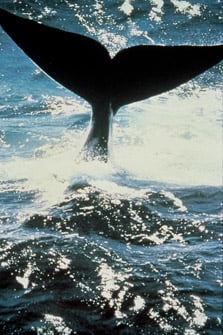
Fluke of Southern Right whale. Photo taken with zoom lens.
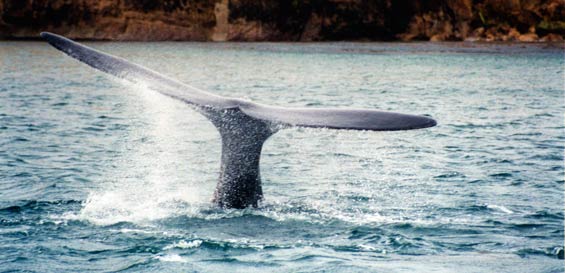
Southern right whale, showing flukes in Karitane, Otago. Photo taken with zoom lens.
Range
These are migratory animals and are circumpolar, mainly between 20°S and 55°S. Two northern species also exist – North Atlantic and North Pacific right whales. Tohorā are a native migrant to New Zealand and are the only large baleen whales that can be seen from the beach. During the breeding season in winter and spring, they are mostly found in the waters around the subantarctic Auckland and Campbell Islands but there are occasional sightings around mainland New Zealand.
Population
Mainland New Zealand and New Zealand's subantarctic appear to represent wintering grounds for one New Zealand population as shown by DNA studies. We do not know if, historically, the two regions were distinct: the mainland New Zealand population could have been wiped out due to whaling and what we see is re-colonisation from the New Zealand subantarctic. Today, the New Zealand population is distinct from neighbouring populations in Australia, based on analysis of genetic markers.
Paternity analysis results also suggest New Zealand right whale calves have fathers from the New Zealand population, consistent with the idea the population is relatively distinct from Australia.
Diet and foraging
These whales can come very close to shore. Aggregations tend to form at feeding grounds, despite many animals typically being solitary or part of a very small group. Dives may last up to an hour but are usually much shorter. Tohorā feed on planktonic crustaceans such as copepods and forage using a technique known as skim feeding, where they open their mouths and slowly swim through large concentrations of prey. As water enters their mouth, prey is sieved from the water and becomes trapped in their fine baleen plates.
Life history
Mating takes place in warm waters in winter with gestation lasting for about 11 months and weaning for about another year. Females are sexually mature at around eight years old with calving generally occurring regularly every three years.
Threats
Killer whales may occasionally kill tohorā. They are known to form hunting packs to take down larger whales but the success rate and frequency of this is largely unknown. Other potential predators are large sharks. Predation is likely to affect calves more than adults. It is possible that such attacks were one of the pressures leading to the evolution of right whales’ use of shallow coastal habitats for calving.
Human impact
Southern right whale populations suffered dramatic losses due to whaling as they were deemed the “right” whales to catch: they were easy to approach, lived close to shore and provided large quantities of meat, oil and whalebone. Both Southern and Northern species came close to extinction and only the Southern is showing signs of recovery.
Present day threats include fishing, coastal development and human harassment. Incidental entanglement in fishing gear has been recorded, with both active fishing gear and lost “ghost” gear posing a threat.
Marine farms and coastal development results in the loss of habitat and can pose problems in terms of competition for both space and food.
Ship strike has also been reported, highlighting the importance of following the Marine Mammal Protection Regulations (1992) when in contact with cetaceans. A combination of these threats no doubt explains why tohorā no longer occur in Wellington Harbour.
DOC's work
Recent findings
Southern right whales seen around mainland New Zealand appear to be part of the New Zealand subantarctic population, which could be undergoing a range expansion. Comparison of genetic markers showed there is no difference between the two New Zealand regions. However, it seems that the New Zealand population is distinct from the populations in Australia, based on the comparison of genetic markers.
Monitoring the species
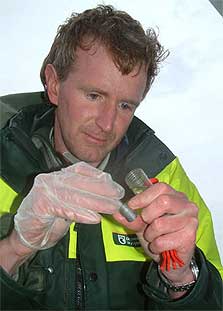
DOC ranger Jim Fyfe checking
Southern right whale DNA samples
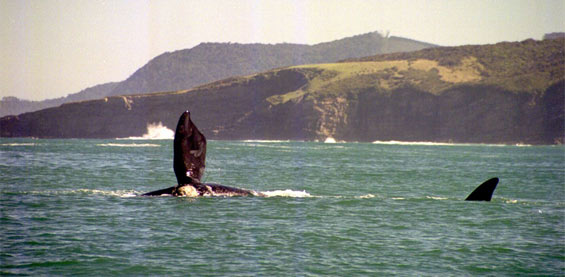
Southern right whale showing side fluke, Tautuku Peninsula
A nationwide research project into the movement patterns of southern right whales was established in 2003. DOC continues to gather sighting information from the public as well as using photo-identification and genetic samples to determine the population status of individuals seen around mainland New Zealand.
Researchers from the University of Auckland have created DNA ‘fingerprints’ to individually identify whales sampled around mainland New Zealand and the New Zealand subantarctic. The New Zealand right whale DNA fingerprint catalogue contains over 700 individually identified whales. Comparison of DNA fingerprints has shown the movement of nine individual whales between the mainland and New Zealand subantarctic.
Current protection and the way forward
The New Zealand population appears to be increasing, based on a mark-recapture study of individuals from the New Zealand subantarctic. This could be associated with the establishment of the Auckland Islands marine mammal sanctuary, where a no-fishing zone exists within a 12-mile radius of the islands. A marine mammal tourism moratorium was also set up at Auckland and Campbell Island. As the New Zealand population increases, it will be important to monitor southern right whales around mainland New Zealand as it may also increase.
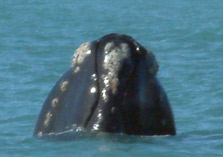
A southern right whale off the
coast of Hokitika. Photo taken with zoom lens
How to identify a southern right whale
These whales can come very close to shore. Adults average 14-15 m and newborn calves between 4.5 and 6 m. Southern right whales are mostly black in colour and can easily be identified by lack of a dorsal fin, a V-shaped blowhole spray and white growths on their heads called callosities.
The pattern of callosities on each whale is different making it possible to identify individuals and to track their movements.
Why sightings are important
During the breeding season in winter and spring, they are mostly found in the waters around the subantarctic Auckland and Campbell Islands but there are occasional sightings around mainland New Zealand. When they visit the mainland, they are often very close to shore in sheltered waters. This is exciting as it provides a rare opportunity for members of the public to see whales from the shore.
We can use the information gathered from sighting reports to monitor the recovery of southern right whales in New Zealand mainland waters.We can keep track of where they go, and find evidence of the whales starting to breed again in mainland New Zealand which would be a really exciting step in the recovery of this species.
Report sightings
You can report sightings of whales to our conservation hotline 0800 DOCHOT (0800 362 468). You can also report a sighting online.
Reports of sightings are always valuable and help increase our knowledge of whale distribution and movements around New Zealand.
If you need help identifying species, download the marine mammal sighting form (PDF, 416K) (Word, 4,300K). You can use the images and descriptions to find out which species of whale you observed.
Record the details
Include as much information as possible with your sighting:
- the date, time and location (GPS coordinates if possible)
- the number of whales and whether any are calves
- the direction they were travelling
- take photographs or video; focus on identifying marks, the left side of the head, and shots of the full length of the body.
How to approach whales (including orca and pilot whales)
From a boat:
- carefully approach whales from the side and slightly to the rear, keeping a distance of at least 50 m at all times
- operate your boat slowly and quietly at ‘no wake’ speed within 300 m
- don't approach a whale if three or more boats are already within 300 m of the animal
- if a whale moves towards your boat, try and manoeuvre out of its path and keep 50 m away; if this is not possible, slow down and stop
- manoeuvre your boat carefully and cooperate with other boats in the area
- don't obstruct the whale’s path, cut through a group or separate mothers from calves
- avoid loud or sudden noises that could startle whales
- don't enter the water; swimming with whales is not permitted. .
You can also help keep their environment clean by taking rubbish home with you or disposing of it appropriately on land. Some rubbish can be lethal to whales.
It is an offence under the Marine Mammals Protection Act 1978 (MMPA) to disturb, harass, harm, injure or kill a whale. Anyone charged under the MMPA with harassing, disturbing, injuring or killing a whale faces a maximum penalty of two years’ imprisonment or a fine to a maximum of $250,000.
If you accidentally catch or harm a whale
If you accidentally catch or harm a whale, including ship strike, you must report it as soon as possible to our conservation hotline 0800 DOCHOT (0800 362 468) or the Ministry for Primary Industries (0800 008 333).
Never attempt to release a whale entangled in a net or rope. Entangled whales are very dangerous and disentanglement should only be undertaken by specially trained personnel. In these circumstance, contact our hotline immediately.
Strandings
Related
Watch The Lost Whales documentary on NZOnScreen: For 150 years, southern right whales (tohorā) were hunted to the brink of extinction, but the discovery of a "lost tribe" in the Southern Ocean sparked hope that their numbers are increasing.
Southern right whale infographic by Xplorio.com
